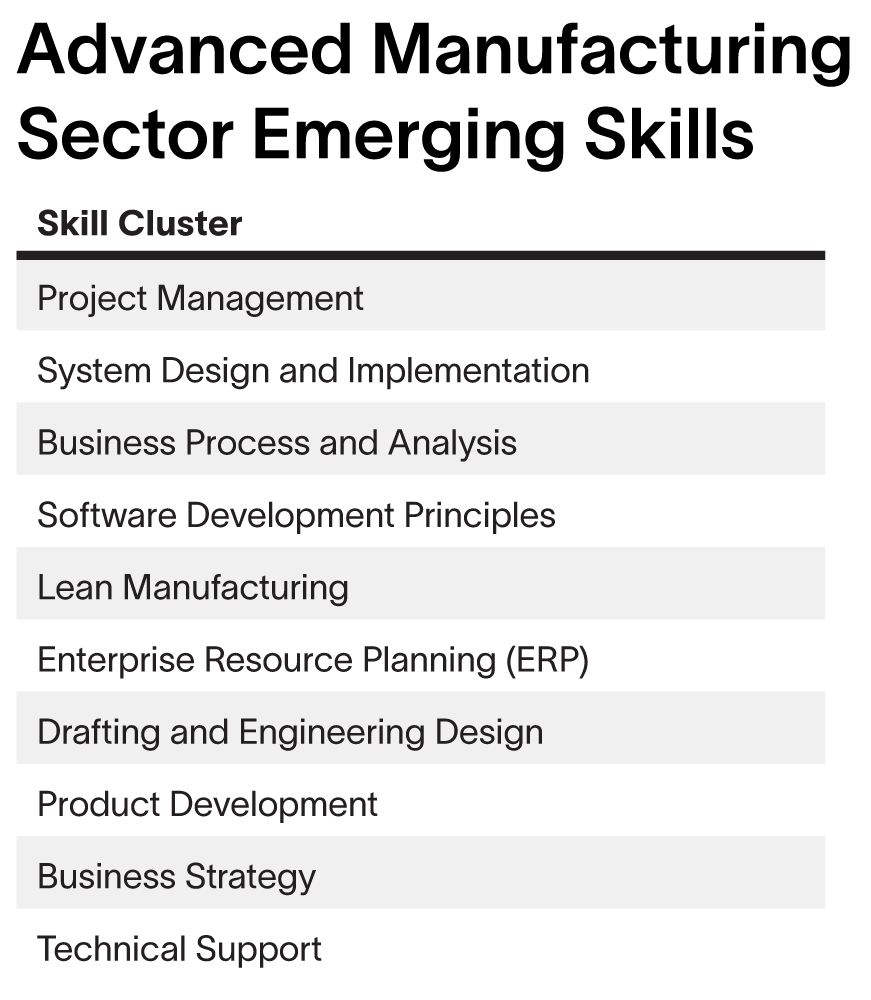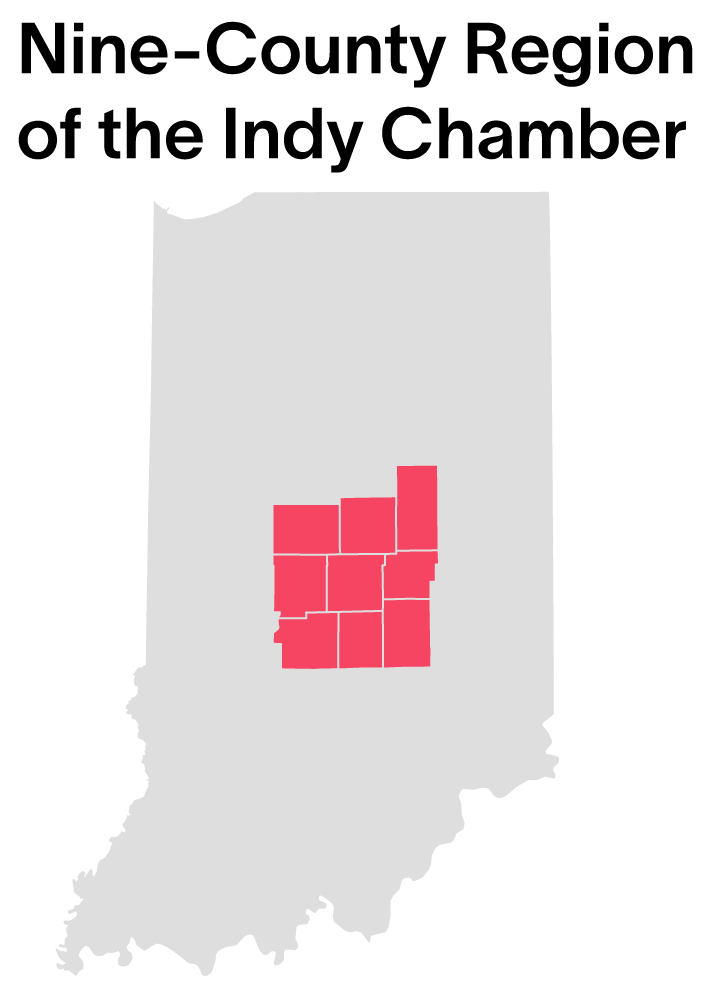The Indianapolis region, with a diverse landscape that spans urban and rural, along with an industry mix of advanced manufacturing, agribusiness, information technology, life sciences, logistics, and sports, has been a success story. Since 2011, the number of jobs in the region has grown from about 865,000 to about 985,000, a 14%increase, greatly exceeding the job growth in the state (7.4%) and the nation (8.3%).
But the region continues to keep moving forward and activate more people, communities, and assets in service of those industries.
An ambitious strategic plan, Accelerate Indy, sought not only to maintain the region’s success but surpass peer markets.
“When looking at our strategic plan, specifically the objectives within the strategic pillars—talent, image, business, and place—I was trying to piece together ways data could build upon and implement the goals outlined,” said Kate Pangallo, Senior Director of Talent & Strategic Partnerships with Indy Partnership, the economic development arm of Indy Chamber. “I knew and could quickly identify that the world had changed in its approach to hiring and training. Skills and a skills approach would be the basis of the data we needed to source.”
Partnering with the Lightcast Community Consulting team, Indy Partnership embarked on a regional skills analysis to identify the skills needed to support target sector growth that would benefit their entire nine-county service area.
What are the skills for growth?
Clarity of what, or rather who, was needed to best attract, retain, and grow businesses was at the forefront of Pangallo’s mind. Workforce has long been the leading decision factor as businesses explore expansion or relocation. But more specifically, it’s now the skills of that workforce.
“The first question businesses ask on site visits is about the workforce. What's the skillset? Who are the institutions producing those skills? We didn't really have a good answer for that,” Pangallo said. “But if we could show our talent pool through skills, not just titles and occupations, but what skills our people have, and how the community is positioned to build on that core skills foundation, we have the potential to have a very different conversation and provide them with the information they need to start and grow their business in Indy.”
To break out of the constricting structures of job titles and occupations, Lightcast and Indy Partnership dove into the skills that comprise those occupations and are distributed across the region and its dominant industry sectors. By looking at Indy’s skills clusters and comparing them to national data, Indy Partnership was able to make the case that the skills—historically understood within finite industry and occupation constructs—are actually collections of regional skills strengths that can be presented in any number of ways, and serve as assets valuable to a range of new firms and sectors including, but not limited to, the firms and sectors where they currently work.

The analysis highlighted skill clusters where demand is currently higher than previous years—as measured by job postings from the last five years. Demand for these skill clusters are likely unmet and notify economic and workforce development leaders of where employers will likely be struggling to find new workers with these skillsets.
For example, the Advanced Manufacturing sector needs more project management, business-oriented skills, and software/technology-related skills than it used to. This data can inform training and programming by local employers and education institutions. The table below shows the top 10 emerging skills clusters.

Strength and emerging skills clusters were examined across all six of Indy Partnership’s target sectors. This confirmed, at a skill level, what Pangallo and other leaders suspected in some areas, but with the specificity needed to actually fill current and future gaps.
“It’s validating to see the roles in skill clusters that were unmet and know our work was already starting to hit on a lot of the areas with workforce teams diving in and creating solutions,” said Pangallo. “But at the same time, we were mostly guessing and looking at national trends of, say, cybersecurity needs. The skills analysis was able to showcase that there’s a need for a heavier focus on not only cybersecurity but other IT-related, skills-heavy occupations in our region. Skills that are paths for our students and talent across the board.”
Skills and career pathing for industry growth
Every region contains a mix of jobs and industries of varying availability, quality, and prospect of advancement and stability, and the Indy region is no exception. The challenge and our opportunity are to understand how the skills used in any job can be applied and built upon to offer better earnings and increasingly promising prospects for the future—both for the workers and for the regional economy.
Within each sector, Ligthcast and Indy Partnership worked to prioritize, narrow, and categorize occupations into three groups.
Opportunity Occupations are jobs with strong demand, are expected to grow, offer a living wage, and are critical to the region’s priority industries. Transitional Occupations are in high demand currently and offer reasonable prospects in the immediate term, but provide a less promising long-term outlook for workers due to lower wages, lower growth expectations, and/or higher risk of displacement due to automation. And Upskill Occupations tend to be entry-level, lower-wage jobs with limited future opportunities but can serve as starting points for more promising and lucrative jobs and careers.

“Understanding the relationship between these types of jobs helps connect all of the Indy region’s workers to high-demand Opportunity Occupations and to see the entire workforce as somewhere on the road to better earnings, greater stability, and contributing to jobs and industries that drive widespread wealth creation and regional prosperity,” says Lightcast Senior Consultant, Ashley Peterson.
“Seeing a worker bringing in 70% of the skills needed was inspiring. They have a starting point,” Pangallo said. “Yes, they don't meet everything, but does anybody? Employers help them get the correct training program, onboarding, learning and development programs to meet these gaps and upskill to success.”
And these transitions aren’t isolated within industries. Skills allow people to break industry confines and use their unique experiences and training wherever they will thrive best. What does this look like in action? Pangallo gave an example in the Sports and Information Technology industries.
“In our technology report, some of our gap areas focused on sales, sales reps, and customer service. When you look at the skills that fall within our sports community, it's literally what they're doing every day,” said Pangallo. “They're bringing overlapping skills that, with some skilling up and some additional education or training, could make an ideal fit for a role in a different sector that recruitment teams have traditionally pulled from.”
As communities face an uphill battle to maintain their economies amidst a tight labor market and possible recession, clearly defined career pathways help leaders provide businesses with their most needed asset—talent. “It truly helped us look and understand the importance that skills play when we're talking about industry growth and opportunity,” concluded Pangallo.
A truly regional approach
The Indy Chamber serves a nine-county region. As the economic development wing of the Chamber, the work of Indy Partnership seeks to benefit the entire regional footprint. This involves aligning the Chamber’s regional goals with the goals of a diverse set of individual communities - urban, rural, suburban. Because skills are transferable across industries, it turns out they are a great way to connect communities regardless of sector focus or specialty.

“Indy Chamber’s holistic view of the region and of its collection of target industries invited us to think more comprehensively, and to be expansive about how to use the data that we have available,” said Joel Simon, VP of Strategy & Growth of Lightcast’s Community division. “We took the view that every county in the region has a role to play in the overall success of the region, and every worker here contributes to a rich talent pool that can be even more beneficial to regional economic prosperity than it is today. Can we learn enough about the skills dispersed throughout the region to see how they can be tapped to create even more regional prosperity?”
“It's a way to connect the dots and look at a community's infrastructure differently. You can ensure it's all thriving around a built ecosystem that supports people and their skills, who we often assume sit just within a particular industry,” said Pangallo.
This approach meant diving into each of the nine counties to understand their skill landscape. Within the Regional Skills Analysis sit nine county-specific breakdowns, providing local leaders with a view of the good jobs there now, projections for future job growth, what other local jobs can serve as feeders for those good jobs, relevant education programs, and opportunities based on asset strengths/challenges. But perhaps most enlightening is the skill strengths that are important across target sectors. This reveals the top skills that workers in the county (in this case, Madison County) have and the regional target sectors for which those skills are a top requested skill.

And the benefits are found not just in the outcome of actionable insights for individual counties, but also in the process itself. “There's a component that, just by doing this report, allowed us to have conversations we didn’t know we should be having,” says Pangallo. “This was an opportunity to support each county through data and analysis, and then look at how a full nine-county region could collaborate and positively impact their goals and efforts.”
“The breakdown of skills strengths in each county and across the region helps us imagine how those strengths can be applied in new ways, in industries not limited to those where they are being applied today,” says Simon. “Workers using their customer service skills in service of the sports sector can now imagine how those same skills can be valued among advanced manufacturing or IT firms.”
Skills as the foundation
For Indy Partnership, the work of understanding the region’s skills is not merely educational. The findings are now at the core of their talent development efforts.
“The Regional Skills Analysis meets the foundational needs of the talent attraction, talent retention, and image pillar work that Indy Chambers is doing. We know talent drives business, not the other way around,” says Pangallo. On a practical level, this is guiding initiatives such as their talent attraction ad campaign. “Understanding our skill gaps over the next five to 10 years in our key industries, and not only that, but right now, our employers need these skills, and we do not have enough. Let's use that as who we're going out and attracting."
In one sense, building this foundation isn’t complicated: people already have skills, so simply build around those skills and fill any gaps. But in another sense, it isn’t easy at all: how do you discover the skills people have, how are they coalescing, and how can they transfer across sectors and roles? Those are big and hard questions to answer.
“Lightcast’s deep data on skills, industries, occupations - all through the regional lens - gave us the ability to unpack these questions, and to look more closely at what the Indy region has to work with, to promote, and to build on,” says Peterson.
And fortunately, the clear vision and goal of Indy Partnership and the Regional Skills Analysis to build skills into their economic development efforts gave Lightcast the framework to help answer those questions. And if the benefits of knowing the skills and clusters needed for industry growth aren’t enough, accolades are always nice too.
“The report has garnered a lot of interest and excitement from other organizations about generating something similar in their own territory. It's definitely put Indy Partnership in a position to show up as a leader in the talent attraction and development space in a way that we hadn't been able to lean on before,” concluded Pangallo.



